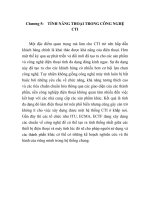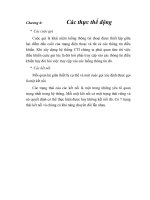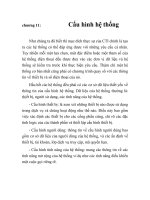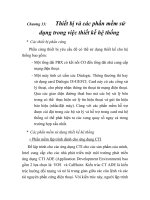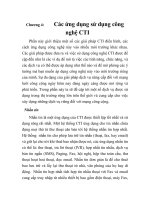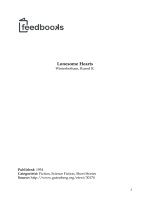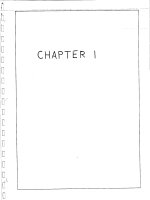Plane Geometry, by George Albert Wentworth ppt
Bạn đang xem bản rút gọn của tài liệu. Xem và tải ngay bản đầy đủ của tài liệu tại đây (2.87 MB, 326 trang )
The Project Gutenberg EBook of Plane Geometry, by George Albert Wentworth
This eBook is for the use of anyone anywhere at no cost and with
almost no restrictions whatsoever. You may copy it, give it away or
re-use it under the terms of the Project Gutenberg License included
with this eBook or online at www.gutenberg.org
Title: Plane Geometry
Author: George Albert Wentworth
Release Date: July 3, 2010 [EBook #33063]
Language: English
Character set encoding: ISO-8859-1
*** START OF THIS PROJECT GUTENBERG EBOOK PLANE GEOMETRY ***
Produced by Jeremy Weatherford, Stan Goodman, Kevin Handy
and the Online Distributed Proofreading Team at
transcriber’s note—Minor typographical corrections and
presentational changes have been made without comment.
This PDF file is optimized for screen viewing, but may easily be
recompiled for printing. Please see the preamble of the L
A
T
E
X source
file for instructions.
PLANE GEOMETRY
BY
G.A. WENTWORTH
Author of a Series of Text-Books in Mathematics
REVISED EDITION
GINN & COMPANY
BOSTON · NEW YORK · CHICAGO · LONDON
Entered, according to Act of Congress, in the year 1888, by
G.A. WENTWORTH
in the Office Of the Librarian of Congress, at Washington
Copyright, 1899
By G.A. WENTWORTH
ALL RIGHTS RESERVED
67 10
The Athenæum Press
GINN & COMPANY · PRO-
PRIETORS · BOSTON · U.S.A.
iii
PREFACE.
Most persons do not possess, and do not easily acquire, the power of ab-
straction requisite for apprehending geometrical conceptions, and for keeping
in mind the successive steps of a continuous argument. Hence, with a very
large proportion of beginners in Geometry, it depends mainly upon the form in
which the subject is presented whether they pursue the study with indifference,
not to say aversion, or with increasing interest and pleasure.
Great care, therefore, has been taken to make the pages attractive. The
figures have been carefully drawn and placed in the middle of the page, so that
they fall directly under the eye in immediate connection with the text; and
in no case is it necessary to turn the page in reading a demonstration. Full,
long-dashed, and short-dashed lines of the figures indicate given, resulting,
and auxiliary lines, respectively. Bold-faced, italic, and roman type has been
skilfully used to distinguish the hypothesis, the conclusion to be proved, and
the proof.
As a further concession to the beginner, the reason for each statement in the
early proofs is printed in small italics, immediately following the statement.
This prevents the necessity of interrupting the logical train of thought by
turning to a previous section, and compels the learner to become familiar with
a large number of geometrical truths by constantly seeing and repeating them.
This help is gradually discarded, and the pupil is left to depend upon the
knowledge already acquired, or to find the reason for a step by turning to the
given reference.
It must not be inferred, because this is not a geometry of interrogation
points, that the author has lost sight of the real object of the study. The
training to be obtained from carefully following the logical steps of a complete
proof has been provided for by the Propositions of the Geometry, and the
development of the power to grasp and prove new truths has been provided
for by original exercises. The chief value of any Geometry consists in the
happy combination of these two kinds of training. The exercises have been
arranged according to the test of experience, and are so abundant that it
is not expected that any one class will work them all out. The methods
of attacking and proving original theorems are fully explained in the first
Book, and illustrated by sufficient examples; and the methods of attacking and
solving original problems are explained in the second Book, and illustrated
iv
by examples worked out in full. None but the very simplest exercises are
inserted until the student has become familiar with geometrical methods, and
is furnished with elementary but much needed instruction in the art of handling
original propositions; and he is assisted by diagrams and hints as long as these
helps are necessary to develop his mental powers sufficiently to enable him to
carry on the work by himself.
The law of converse theorems, the distinction between positive and negative
quantities, and the principles of reciprocity and continuity have been briefly
explained; but the application of these principles is left mainly to the discretion
of teachers.
The author desires to express his appreciation of the valuable suggestions
and assistance which he has received from distinguished educators in all parts
of the country. He also desires to acknowledge his obligation to Mr. Charles
Hamilton, the Superintendent of the composition room of the Athenæum
Press, and to Mr. I. F. White, the compositor, for the excellent typography of
the book.
Criticisms and corrections will be thankfully received.
G. A. WENTWORTH.
Exeter, N.H., June, 1899.
v
NOTE TO TEACHERS.
It is intended to have the first sixteen pages of this book simply read in
the class, with such running comment and discussion as may be useful to help
the beginner catch the spirit of the subject-matter, and not leave him to the
mere letter of dry definitions. In like manner, the definitions at the beginning
of each Book should be read and discussed in the recitation room. There is a
decided advantage in having the definitions for each Book in a single group so
that they can be included in one survey and discussion.
For a similar reason the theorems of limits are considered together. The
subject of limits is exceedingly interesting in itself, and it was thought best to
include in the theory of limits in the second Book every principle required for
Plane and Solid Geometry.
When the pupil is reading each Book for the first time, it will be well to let
him write his proofs on the blackboard in his own language, care being taken
that his language be the simplest possible, that the arrangement of work be
vertical, and that the figures be accurately constructed.
This method will furnish a valuable exercise as a language lesson, will
cultivate the habit of neat and orderly arrangement of work, and will allow a
brief interval for deliberating on each step.
After a Book has been read in this way, the pupil should review the Book,
and should be required to draw the figures free-hand. He should state and
prove the propositions orally, using a pointer to indicate on the figure every
line and angle named. He should be encouraged in reviewing each Book, to
do the original exercises; to state the converse propositions, and determine
whether they are true or false; and also to give well-considered answers to
questions which may be asked him on many propositions.
The Teacher is strongly advised to illustrate, geometrically and arithmeti-
cally, the principles of limits. Thus, a rectangle with a constant base b, and
a variable altitude x, will afford an obvious illustration of the truth that the
product of a constant and a variable is also a variable; and that the limit of
the product of a constant and a variable is the product of the constant by the
limit of the variable. If x increases and approaches the altitude a as a limit,
the area of the rectangle increases and approaches the area of the rectangle ab
as a limit; if, however, x decreases and approaches zero as a limit, the area of
the rectangle decreases and approaches zero as a limit.
vi
An arithmetical illustration of this truth may be given by multiplying the
approximate values of any repetend by a constant. If, for example, we take
the repetend 0.3333 etc., the approximate values of the repetend will be
3
10
,
33
100
,
333
1000
,
3333
10000
, etc., and these values multiplied by 60 give the series 18, 19.8,
19.98, 19.998, etc., which evidently approaches 20 as a limit; but the product
of 60 into
1
3
(the limit of the repetend 0.333 etc.) is also 20.
Again, if we multiply 60 into the different values of the decreasing series
1
30
,
1
300
,
1
3000
,
1
30000
, etc., which approaches zero as a limit, we shall get the
decreasing series 2,
1
5
,
1
50
,
1
500
, etc.; and this series evidently approaches zero
as a limit.
The Teacher is likewise advised to give frequent written examinations.
These should not be too difficult, and sufficient time should be allowed for
accurately constructing the figures, for choosing the best language, and for
determining the best arrangement.
The time necessary for the reading of examination books will be diminished
by more than one half, if the use of symbols is allowed.
Exeter, N.H., 1899.
CONTENTS vii
Contents
GEOMETRY. 1
INTRODUCTION. . . . . . . . . . . . . . . . . . . . . . . . . 1
GENERAL TERMS. . . . . . . . . . . . . . . . . . . . . . . . 3
GENERAL AXIOMS. . . . . . . . . . . . . . . . . . . . . . . 6
SYMBOLS AND ABBREVIATIONS. . . . . . . . . . . . . . . 6
PLANE GEOMETRY. 7
BOOK I. RECTILINEAR FIGURES. 7
DEFINITIONS. . . . . . . . . . . . . . . . . . . . . . . . . . . 7
THE STRAIGHT LINE. . . . . . . . . . . . . . . . . . . . . . 8
THE PLANE ANGLE. . . . . . . . . . . . . . . . . . . . . . . 10
PERPENDICULAR AND OBLIQUE LINES. . . . . . . . . . 17
PARALLEL LINES. . . . . . . . . . . . . . . . . . . . . . . . 26
TRIANGLES. . . . . . . . . . . . . . . . . . . . . . . . . . . . 33
LOCI OF POINTS. . . . . . . . . . . . . . . . . . . . . . . . . 48
QUADRILATERALS. . . . . . . . . . . . . . . . . . . . . . . 51
POLYGONS IN GENERAL. . . . . . . . . . . . . . . . . . . . 61
SYMMETRY. . . . . . . . . . . . . . . . . . . . . . . . . . . . 65
EXERCISES. . . . . . . . . . . . . . . . . . . . . . . . . . . . 72
CONTENTS viii
BOOK II. THE CIRCLE. 89
DEFINITIONS. . . . . . . . . . . . . . . . . . . . . . . . . . . 89
ARCS, CHORDS, AND TANGENTS. . . . . . . . . . . . . . 91
MEASUREMENT. . . . . . . . . . . . . . . . . . . . . . . . . 109
THEORY OF LIMITS. . . . . . . . . . . . . . . . . . . . . . . 111
MEASURE OF ANGLES. . . . . . . . . . . . . . . . . . . . . 119
PROBLEMS OF CONSTRUCTION. . . . . . . . . . . . . . . 135
EXERCISES. . . . . . . . . . . . . . . . . . . . . . . . . . . . 158
BOOK III. PROPORTION. SIMILAR POLYGONS. 168
THEORY OF PROPORTION. . . . . . . . . . . . . . . . . . 168
SIMILAR POLYGONS. . . . . . . . . . . . . . . . . . . . . . 183
EXERCISES. . . . . . . . . . . . . . . . . . . . . . . . . . . . 195
NUMERICAL PROPERTIES OF FIGURES. . . . . . . . . . 197
EXERCISES. . . . . . . . . . . . . . . . . . . . . . . . . . . . 207
PROBLEMS OF CONSTRUCTION. . . . . . . . . . . . . . . 210
EXERCISES. . . . . . . . . . . . . . . . . . . . . . . . . . . . 216
BOOK IV. AREAS OF POLYGONS. 226
COMPARISON OF POLYGONS. . . . . . . . . . . . . . . . . 235
EXERCISES. . . . . . . . . . . . . . . . . . . . . . . . . . . . 239
PROBLEMS OF CONSTRUCTION. . . . . . . . . . . . . . . 242
EXERCISES. . . . . . . . . . . . . . . . . . . . . . . . . . . . 252
BOOK V. REGULAR POLYGONS AND CIRCLES. 258
PROBLEMS OF CONSTRUCTION. . . . . . . . . . . . . . . 274
MAXIMA AND MINIMA. . . . . . . . . . . . . . . . . . . . . 282
EXERCISES. . . . . . . . . . . . . . . . . . . . . . . . . . . . 289
TABLE OF FORMULAS. 302
INDEX. 305
GEOMETRY.
INTRODUCTION.
1. If a block of wood or stone is cut in the shape represented in Fig. 1, it
will have six flat faces.
Each face of the block is called a surface; and if the faces are made smooth
by polishing, so that, when a straight edge is applied to any one of them, the
straight edge in every part will touch the surface, the faces are called plane
surfaces, or planes.
Fig. 1.
2. The intersection of any two of these surfaces is called a line.
3. The intersection of any three of these lines is called a point.
4. The block extends in three principal directions:
From left to right, A to B.
From front to back, A to C.
From top to bottom, A to D.
These are called the dimensions of the block, and are named in the order
given, length, breadth (or width), and thickness (height or depth).
GEOMETRY. 2
5. A solid, in common language, is a limited portion of space filled with
matter; but in Geometry we have nothing to do with the matter of which a
body is composed; we study simply its shape and size; that is, we regard a
solid as a limited portion of space which may be occupied by a physical body,
or marked out in some other way. Hence,
A geometrical solid is a limited portion of space.
6. The surface of a solid is simply the boundary of the solid, that which
separates it from surrounding space. The surface is no part of a solid and has
no thickness. Hence,
A surface has only two dimensions, length and breadth.
7. A line is simply a boundary of a surface, or the intersection of two sur-
faces. Since the surfaces have no thickness, a line has no thickness. Moreover,
a line is no part of a surface and has no width. Hence,
A line has only one dimension, length.
8. A point is simply the extremity of a line, or the intersection of two lines.
A point, therefore, has no thickness, width, or length; therefore, no magnitude.
Hence,
A point has no dimension, but denotes position simply.
9. It must be distinctly understood at the outset that the points, lines,
surfaces, and solids of Geometry are purely ideal, though they are represented
to the eye in a material way. Lines, for example, drawn on paper or on the
blackboard, will have some width and some thickness, and will so far fail of
being true lines; yet, when they are used to help the mind in reasoning, it is
assumed that they represent true lines, without breadth and without thickness.
A
B
C D
F
Fig. 2.
10. A point is represented to the eye by a fine dot, and named by a letter,
as A (Fig. 2). A line is named by two letters, placed one at each end, as BF .
A surface is represented and named by the lines which bound it, as BCDF .
A solid is represented by the faces which bound it.
GENERAL TERMS. 3
11. A point in space may be considered by itself, without reference to a
line.
12. If a point moves in space, its path is a line. This line may be considered
apart from the idea of a surface.
13. If a line moves in space, it generates, in general, a surface. A surface
can then be considered apart from the idea of a solid.
14. If a surface moves in space, it generates, in general, a solid.
A
B
C
D
E
F
G
H
Fig. 3.
Thus, let the upright surface ABCD (Fig. 3) move to the right to the
position EF GH, the points A, B, C, and D generating the lines AE, BF ,
CG, and DH, respectively. The lines AB, BC, CD, and DA will generate
the surfaces AF . BG, CH, and DE, respectively. The surface ABCD will
generate the solid AG.
15. Geometry is the science which treats of position, form, and magni-
tude.
16. A geometrical figure is a combination of points, lines, surfaces, or
solids.
17. Plane Geometry treats of figures all points of which are in the same
plane.
Solid Geometry treats of figures all points of which are not in the same
plane.
GENERAL TERMS.
18. A proof is a course of reasoning by which the truth or falsity of any
statement is logically established.
GEOMETRY. 4
19. An axiom is a statement admitted to be true without proof.
20. A theorem is a statement to be proved.
21. A construction is the representation of a required figure by means of
points and lines.
22. A postulate is a construction admitted to be possible.
23. A problem is a construction to be made so that it shall satisfy certain
given conditions.
24. A proposition is an axiom, a theorem, a postulate, or a problem.
25. A corollary is a truth that is easily deduced from known truths.
26. A scholium is a remark upon some particular feature of a proposition.
27. The solution of a problem consists of four parts:
1. The analysis, or course of thought by which the construction of the
required figure is discovered.
2. The construction of the figure with the aid of ruler and compasses.
3. The proof that the figure satisfies all the conditions.
4. The discussion of the limitations, if any, within which the solution is
possible.
28. A theorem consists of two parts: the hypothesis, or that which is
assumed; and the conclusion, or that which is asserted to follow from the
hypothesis.
29. The contradictory of a theorem is a theorem which must be true
if the given theorem is false, and must be false if the given theorem is true.
Thus,
A theorem:
If A is B, then C is D.
Its contradictory: If A is B, then C is not D.
GENERAL TERMS. 5
30. The opposite of a theorem is obtained by making both the hypothesis
and the conclusion negative. Thus,
A theorem:
If A is B, then C is D.
Its opposite:
If A is not B, then C is not D.
31. The converse of a theorem is obtained by interchanging the hypothesis
and conclusion. Thus,
A theorem:
If A is B, then C is D.
Its converse:
If C is D, then A is B.
32. The converse of a truth is not necessarily true.
Thus, Every horse is a quadruped is true, but the converse, Every quadru-
ped is a horse, is not true.
33. If a direct proposition and its opposite are true, the converse proposition
is true; and if a direct proposition and its converse are true, the opposite
proposition is true.
Thus, if it were true that
1. If an animal is a horse, the animal is a quadruped;
2. If an animal is not a horse, the animal is not a quadruped;
it would follow that
3. If an animal is a quadruped, the animal is a horse.
Moreover, if 1 and 3 were true, then 2 would be true.
GEOMETRY. 6
34. GENERAL AXIOMS.
1. Magnitudes which are equal to the same magnitude, or equal magni-
tudes, are equal to each other.
2. If equals are added to equals, the sums are equal.
3. If equals are taken from equals, the remainders are equal.
4. If equals are added to unequals, the sums are unequal in the same order;
if unequals are added to unequals in the same order, the sums are unequal in
that order.
5. If equals are taken from unequals, the remainders are unequal in the
same order; if unequals are taken from equals, the remainders are unequal in
the reverse order.
6. The doubles of the same magnitude, or of equal magnitudes are equal;
and the doubles of unequals are unequal.
7. The halves of the same magnitude, or of equal magnitudes are equal;
and the halves of unequals are unequal.
8. The whole is greater than any of its parts.
9. The whole is equal to the sum of all its parts.
35. SYMBOLS AND ABBREVIATIONS.
> is (or are) greater than. Def. . . . definition.
< is (or are) less than. Ax. . . . axiom.
is (or are) equivalent to. Hyp. . . . hypothesis.
∴ therefore. Cor. . . . corollary.
⊥ perpendicular. Scho. . . . scholium.
⊥
s
perpendiculars. Ex. . . . exercise.
parallel.
s
parallels. Adj. . . . adjacent.
∠ angle. ∠
s
angles. Iden. . . . identical.
triangle.
s
triangles. Const . . construction.
/ /
parallelogram. Sup. . . . supplementary.
/ /
s
parallelograms. Ext. . . . exterior.
circle.
s
circles. Int. . . . interior.
rt. right. st. straight. Alt. . . . alternate.
q.e.d. stands for quod erat demonstrandum, which was to be proved.
q.e.f. stands for quod erat faciendum, which was to be done.
The signs +, −, ×, ÷, =, have the same meaning as in Algebra.
PLANE GEOMETRY.
BOOK I. RECTILINEAR FIGURES.
DEFINITIONS.
A B
C
D
E F
Fig. 4.
36. A straight line is a line such that any part of it, however placed on
any other part, will lie wholly in that part if its extremities lie in that part,
as AB.
37. A curved line is a line no part of which is straight, as CD.
38. A broken line is made up of different straight lines, as EF .
Note. A straight line is often called simply a line.
39. A plane surface, or a plane, is a surface in which, if any two points
are taken, the straight line joining these points lies wholly in the surface.
40. A curved surface is a surface no part of which is plane.
41. A plane figure is a figure all points of which are in the same plane.
42. Plane figures which are bounded by straight lines are called rectilinear
figures; by curved lines, curvilinear figures.
43. Figures that have the same shape are called similar. Figures that have
the same size but not the same shape are called equivalent. Figures that have
the same shape and the same size are called equal or congruent.
BOOK I. PLANE GEOMETRY. 8
THE STRAIGHT LINE.
44. Postulate. A straight line can be drawn from one point to another.
45. Postulate. A straight line can be produced indefinitely.
46. Axiom.
∗
Only one straight line can be drawn from one point to an-
other. Hence, two points determine a straight line.
47. Cor. 1. Two straight lines which have two points in common coincide
and form but one line.
48. Cor. 2. Two straight lines can intersect in only one point.
For if they had two points common, they would coincide and not intersect.
Hence, two intersecting lines determine a point.
49. Axiom. A straight line is the shortest line that can be drawn from one
point to another.
50. Def. The distance between two points is the length of the straight
line that joins them.
51. A straight line determined by two points may be considered as pro-
longed indefinitely.
52. If only the part of the line between two fixed points is considered, this
part is called a segment of the line.
53. For brevity, we say “the line AB,” to designate a segment of a line
limited by the points A and B.
54. If a line is considered as extending from a fixed point, this point is
called the origin of the line.
∗
The general axioms on page 6 apply to all magnitudes. Special geometrical axioms will
be given when required.
THE STRAIGHT LINE. 9
A B
C
Fig. 5.
55. If any point, C, is taken in a given straight line, AB, the two parts CA
and CB are said to have opposite directions from the point C (Fig. 5).
Every straight line, as AB, may be considered as extending in either of two
opposite directions, namely, from A towards B, which is expressed by AB, and
read segment AB; and from B towards A, which is expressed by BA, and read
segment BA.
56. If the magnitude of a given line is changed, it becomes longer or shorter.
Thus (Fig. 5), by prolonging AC to B we add CB to AC, and AB = AC +
CB. By diminishing AB to C, we subtract CB from AB, and AC = AB−CB.
If a given line increases so that it is prolonged by its own magnitude several
times in succession, the line is multiplied, and the resulting line is called a
multiple of the given line.
A B C D E
Fig. 6.
Thus (Fig. 6), if AB = BC = CD = DE, then AC = 2AB, AD = 3AB,
and AE = 4AB. Hence,
Lines of given length may be added and subtracted; they may also be mul-
tiplied by a number.
BOOK I. PLANE GEOMETRY. 10
THE PLANE ANGLE.
DE
F
Fig. 7.
57. The opening between two straight lines drawn from the same point is
called a plane angle. The two lines, ED and EF , are called the sides, and
E, the point of meeting, is called the vertex of the angle.
The size of an angle depends upon the extent of opening of its sides, and
not upon the length of its sides.
58. If there is but one angle at a given vertex, the angle is designated by
a capital letter placed at the vertex, and is read by simply naming the letter.
A
BC D
E F
Fig. 8.
A B
a
bc
d
Fig. 9.
If two or more angles have the same vertex, each angle is designated by
three letters, and is read by naming the three letters, the one at the vertex
between the others. Thus, DAC (Fig. 8) is the angle formed by the sides AD
and AC.
An angle is often designated by placing a small italic letter between the
sides and near the vertex, as in Fig. 9.
59. Postulate of Superposition. Any figure may be moved from one
place to another without altering its size or shape.
60. The test of equality of two geometrical magnitudes is that they may
be made to coincide throughout their whole extent. Thus,
Two straight lines are equal, if they can be placed one upon the other so
that the points at their extremities coincide.
Two angles are equal, if they can be placed one upon the other so that
their vertices coincide and their sides coincide, each with each.
THE PLANE ANGLE. 11
61. A line or plane that divides a geometric magnitude into two equal parts
is called the bisector of the magnitude.
If the angles BAD and CAD (Fig. 8) are equal, AD bisects the angle BAC.
62. Two angles are called adjacent angles when they have the same vertex
and a common side between them; as the angles BOD and AOD (Fig. 10).
A B
D
O
Fig. 10.
A BC
D
Fig. 11.
63. When one straight line meets another straight line and makes the
adjacent angles equal, each of these angles is called a right angle; as angles
DCA and DCB (Fig. 11).
64. A perpendicular to a straight line is a straight line that makes a right
angle with it.
Thus, if the angle DCA (Fig. 11) is a right angle, DC is perpendicular to
AB, and AB is perpendicular to DC.
65. The point (as C, Fig. 11) where a perpendicular meets another line is
called the foot of the perpendicular.
66. When the sides of an angle extend in opposite directions, so as to be
in the same straight line, the angle is called a straight angle.
A B
C
Fig. 12.
Thus, the angle formed at C (Fig. 12) with its sides CA and CB extending
in opposite directions from C is a straight angle.
67. Cor. A right angle is half a straight angle.
BOOK I. PLANE GEOMETRY. 12
A
Fig. 13.
A
D
O
Fig. 14.
68. An angle less than a right angle is called an acute angle; as, angle A
(Fig. 13).
69. An angle greater than a right angle and less than a straight angle is
called an obtuse angle; as, angle AOD (Fig. 14).
70. An angle greater than a straight angle and less than two straight angles
is called a reflex angle; as, angle DOA, indicated by the dotted line (Fig. 14).
71. Angles that are neither right nor straight angles are called oblique
angles; and intersecting lines that are not perpendicular to each other are
called oblique lines.
THE PLANE ANGLE. 13
EXTENSION OF THE MEANING OF ANGLES.
A
B
C
D
O
A
′
B
′
Fig. 15.
72. Suppose the straight line OC (Fig. 15) to move in the plane of the paper
from coincidence with OA, about the point O as a pivot, to the position OC;
then the line OC describes or generates the angle AOC, and the magnitude
of the angle AOC depends upon the amount of rotation of the line from the
position OA to the position OC.
If the rotating line moves from the position OA to the position OB, per-
pendicular to OA, it generates the right angle AOB; if it moves to the position
OD, it generates the obtuse angle AOD; if it moves to the position OA
, it
generates the straight angle AOA
; if it moves to the position OB
it generates
the reflex angle AOB
, indicated by the dotted line; and if it moves to the
position OA again, it generates two straight angles. Hence,
73. The angular magnitude about a point in a plane is equal to two straight
angles, or four right angles; and the angular magnitude about a point on one
side of a straight line drawn through the point is equal to a straight angle, or
two right angles.
74. The whole angular magnitude about a point in a plane is called a
perigon; and two angles whose sum is a perigon are called conjugate angles.
Note. This extension of the meaning of angles is necessary in the applications
of Geometry, as in Trigonometry, Mechanics, etc.
BOOK I. PLANE GEOMETRY. 14
a
b
c
d
Fig. 16.
B
C
D
O
Fig. 17.
A B
D
O
Fig. 18.
75. When two angles have the same vertex, and the sides of the one are
prolongations of the sides of the other, they are called vertical angles; as,
angles a and b, c and d (Fig. 16).
76. Two angles are called complementary when their sum is equal to a
right angle; and each is called the complement of the other; as, angles DOB
and DOC (Fig. 17).
77. Two angles are called supplementary when their sum is equal to a
straight angle; and each is called the supplement of the other; as, angles DOB
and DOA (Fig. 18).
UNIT OF ANGLES.
78. By adopting a suitable unit for measuring angles we are able to express
the magnitudes of angles by numbers.
If we suppose OC (Fig. 15) to turn about O from coincidence with OA
until it makes one three hundred sixtieth of a revolution, it generates an angle
at O, which is taken as the unit for measuring angles. This unit is called a
degree.
The degree is subdivided into sixty equal parts, called minutes, and the
minute into sixty equal parts, called seconds.
Degrees, minutes, and seconds are denoted by symbols. Thus, 5 degrees
13 minutes 12 seconds is written 5
◦
13
12
.
A right angle is generated when OC has made one fourth of a revolution
and contains 90
◦
; a straight angle, when OC has made half of a revolution
and contains 180
◦
; and a perigon, when OC has made a complete revolution
and contains 360
◦
.
THE PLANE ANGLE. 15
Note. The natural angular unit is one complete revolution. But this unit would
require us to express the values of most angles by fractions. The advantage of using
the degree as the unit consists in its convenient size, and in the fact that 360 is
divisible by so many different integral numbers.
AB
C
DE
F
G
H
Fig. 19.
79. By the method of superposition we are able to compare magnitudes of
the same kind. Suppose we have two angles, ABC and DEF (Fig. 19). Let
the side ED be placed on the side BA, so that the vertex E shall fall on B;
then, if the side EF falls on BC, the angle DEF equals the angle ABC; if
the side EF falls between BC and BA in the position shown by the dotted
line BG, the angle DEF is less than the angle ABC; but if the side EF falls
in the position shown by the dotted line BH, the angle DEF is greater than
the angle ABC.
